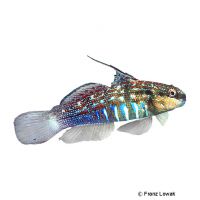Halfbarred Goby (Amblygobius semicinctus)
| Halfbarred Goby Amblygobius semicinctus | |
|---|---|
| Name | Halfbarred Goby |
| Name Lat. | Amblygobius semicinctus |
| Family | Gobies |
| Family lat. | Gobiidae |
| Order | Gobies |
| Order lat. | Gobiiformes |
| Origin | Indian Ocean |
| Habitat | Inshore reefs, lagoons |
| Diet | Omnivore |
| pH | 8.1-8.4 |
| Hardness | 8-10 °KH |
| Behavior | Peaceful |
| Keeping | Pair |
| Reef Compatible | Yes |
| Care Level | Moderate |
| Life Span | 2-5 years |
| Protection | No |
| Metric Units | |
| Size | 11 cm |
| Temperature | 22-30 °C |
| Salinity | 33-36 ‰ |
| Aquarium | ~ 200 l |
| US Units | |
| Size | 4" |
| Temperature | 72-86 °F |
| Salinity | 1.020-1.025 sg |
| Aquarium | ~ 50 gal |
Distribution and habitat
Amblygobius semicinctus are widely distributed throughout the tropical Indian Ocean, from East Africa to Indonesia and the northwest coast of Australia. They live mostly in pairs in the sandy, boulder-rich zones of shallow, algae-rich reefs protected from strong surf, down to 30 m depth.
Maintenance
They need a well-structured aquarium with rock or stone structures with living stones, which offer sufficient hiding and covering possibilities as well as sufficient swimming space and a substrate consisting of a layer of fine sand at least 6 cm thick (no coral rubble!). Only lime-rich, heavy metal-free sands, gravels, stones or sea sand may be used.
Filters, skimmers and heaters are necessary to ensure water quality, as well as pumps to simulate tides, swells and bottom currents. Lighting must be appropriate for the species' day-night rhythm
| Salinity: 33-36 ‰ | pH value: 8.1-8.4 |
| Carbonate hardness: 8-10 °KH | Nitrate content: 2-8 mg/l |
| phosphate content: 0.01-0.1 mg/l | nitrite content: 0.0-0.05 mg/l |
For salinity, an average value should be aimed for, which may only vary slightly by +/- 0.5 ‰. Ammonia and ammonium must not be measurable. Special attention must be paid to constantly good water quality.
Diet
In nature they feed mainly on zooplankton and algae. The feed change usually succeeds without problems. The food supply should consist of a combination of small mysis, artemia and cyclops. In addition, chopped shrimp and crab meat as well as a frozen food mixture enriched with vitamins for plankton eaters. High-quality flake and granulated food with a high vegetable content is also often accepted after a period of acclimatization. It is recommended to feed small portions several times a day.
Regular and varied feeding promotes health and increases resistance.
Behaviour and compatibility
They are monogamous and should only be kept in pairs. Within the species they occasionally behave territorially. Keeping several pairs is only recommended in a larger and richly structured tank. Towards other fish they behave peacefully, whereby too small fish are considered as food.
Sex dimorphism
There are no known external distinguishing characteristics.
Reproduction and breeding
There are no known reports of successful breeding in the aquarium.
Important
Due to the special form of feeding, they sift the sand for microorganisms, the substrate is always kept clean. However, shells and corals can be damaged by sand deposits. They like to pluck algae and can also be used to combat cyanobacteria
At night or in case of danger they retreat into self-dug caves under stones or coral blocks, accordingly the reef construction must be well secured.
If different species are kept together, care must be taken to ensure that the fish match each other in terms of water quality and temperature requirements, as well as their social behavior, and that the setup meets the needs of all species kept together. New fish to be introduced must be acclimated slowly to the water in the aquarium
Further literature can be found in your pet store.
References
Text: Werner Winter; Image: Franz Lowak
Source: KUITER, DEBELIUS (2007): Atlas der Meeresfische: Die Fische an den Küsten der Weltmeere, Kosmos Verlag; ENGELMANN (2005): Zootierhaltung - Tiere in menschlicher Obhut: Fische, Verlag Harri Deutsch
- Gemäß § 21 Abs. 5 Tierschutzgesetz idgF
